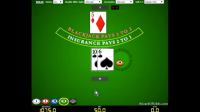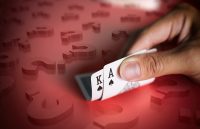How to Play Blackjack
 Blackjack Variations > Blackjack
Blackjack Variations > Blackjack
Blackjack is a casino table game in which players try to make hands which score as close to 21 points without going over. In order to win, players must make a better hand than the dealer. While it may sound simple, blackjack is an exciting game of strategy, luck, odds and risks, which has made blackjack one of the most popular gambling games in the world.
Editor’s Picks for Best Online Blackjack in 2025
- Online and mobile blackjack
- Casino, Poker & Sportsbook
- Fast Bitcoin withdrawals
$3,000
- Live Dealer Blackjack
- 24/7 Live Support
- Trusted since 2007
- Online and mobile blackjack
- Great for U.S. based players
- New and fresh
- Highly rated blackjack casino
- Vegas style blackjack
- Welcomes American players
$11,000
The Basics of How to Play Blackjack
Every game of blackjack starts in the same way: each player makes a bet. In any given game of blackjack, there can be anywhere from one to several players competing against the dealer; however, each player plays against the dealer independently, and in any given hand, some players may win while others might lose. For the sake of simplicity in this article, all examples will feature just a single player.
The player and the dealer are both dealt initial two card hands out of a shoe, which contains some number of standard 52-card decks – usually, between one and eight decks. Both of the player’s cards are face up, while the dealer will have one card face up (known as the up card), and one card face down.
Scoring Blackjack Hands
Each card in blackjack is worth a different number of points. Numbered cards – those of ranks between two and ten – are worth a number of points equal to their printed rank. For instance, a seven is worth seven points. Face cards – jacks, queens and kings – are each worth ten points.
Aces can be worth either one or eleven points. Essentially, aces are worth eleven points unless that would result in the hand going over 21 points, in which case they can count as one point instead. Hands with an ace that still counts as eleven points are known as “soft” hands, as opposed to those in which aces must count as one point, which are known as “hard” hands. The difference is that a soft hand cannot go over 21 with an additional card, since the ace may simply go from counting as eleven to being worth a single point.
Blackjacks and Insurance
If the player starts with a hand that is worth 21 points – in other words, an ace and a ten or face card – then the player has a blackjack. This will almost always result in the player immediately winning. The odds paid for a blackjack are normally 3-2, though some tables may only offer 6-5 or other unusual odds.
However, it is also possible for the dealer to have a blackjack. If the dealer’s up card is an ace or a ten-point card, the dealer will check to see if they have a blackjack (under some rules, the dealer will only check at this point if the up card is an ace). If the dealer has a blackjack, all players immediately lose, unless the player also has a blackjack, in which case they push.
In addition, if the dealer is showing an ace, the dealer will offer insurance to players. Players may purchase insurance for half the price of their initial bet. If the dealer has a blackjack, the insurance bet pays 2-1; the net result of winning the insurance bet but losing the original bet is for the player to come out even for the hand. If a player has a blackjack, most dealers will over “even money” for the blackjack, offering a 1-1 payout as an alternative to risking a push if the dealer also has blackjack. This is simply the insurance bet under another name.
Hitting and Standing in Blackjack
Assuming the neither the player or dealer has a blackjack, the player now has some choices to make regarding their hand. In making these decisions, the player should take into account both his own hand, as well as the dealer’s exposed card.
If the player is happy with his hand and doesn’t wish to risk taking any additional cards, he may stand. This ends their options and locks in their hand on whatever score they currently have.
Alternately, the player can “hit.” If a player hits, the dealer deals another card to them. If this card takes the hand over 21 points, the player “busts,” and loses all bets immediately. Otherwise, the player again has the choice of hitting or standing. A player may hit as many times as they like, provided they do not exceed 21 points. Once a player chooses to stand, they are done playing their hand.
The Dealer’s Hand
Once all players have played their hand, the dealer reveals their second card. The dealer may now attempt to improve their hand, based on rules that should be printed on the table. In most cases, the dealer must hit with a hand of 16 or less, and must stand with a hand of 17 or greater. The dealer will continue hitting until the rules tell the dealer to stand, or the dealer busts.
If the dealer busts, all players remaining in the hand immediately win even money on their bets. If the dealer stands, the player’s hand is compared to the dealer’s hand. If the player’s hand is higher, the player wins even money on all bets. If the player’s hand is lower, the player loses all bets. If the player and dealer tie, all bets push.
Example Hand #1
The player is dealt 5/3, for a hand worth 8 points. The dealer is showing a K. The player chooses to hit, and receives a Q, making his hand worth 18 points. The player now chooses to stand.
The dealer reveals his down card, showing a 6. The dealer now has K/6, worth 16 points. The rules say that the dealer must hit with 16, and therefore takes another card. He receives a 7, bringing his hand to 23 points. This means that the dealer busts, and the player wins even money on his bet.
Splitting and Doubling Down
Players also have two other options that they may invoke when they receive their initial two card hand. If the player has two cards of the same rank, they may choose to split their hand into two. This is done by making a second bet of equal size to the original bet. The two cards are separated into two separate hands, each of which is dealt a new second card. Under many rules systems, players are allowed to split their hands additional times if they receive a pair after splitting. For instance, if a player starts with 44, then chooses to split, they may end up with two hands of A4 and 44. The player may then split the new 44 hands, resulting in a total of three hands, each being played for a single bet. Each of these hands wins or losses individually, so it is possible to win some hands and lose others after splitting.
The player may also choose to double down on their first two cards. By doubling down, a player agrees to take only one more card, after which they will stand, meaning they are stuck with whatever hand they have after receiving their third card. If a player wishes to do this, they will need to make a second bet of equal size (if they do not have enough money to do this, they may double down for less than the original bet size). This option allows the player to wager more money when the odds are strongly in their favor, with the accompanying risk of ending up with a bad hand that they normally would have continued hitting with.
Example Hand #2
The following hand covers many possible situations in blackjack. Follow it carefully; if you understand what has happened in this hand, you should feel comfortable playing blackjack online or at a casino!
The player begins with the hand of 8/8 (16 points), while the dealer begins with an ace showing (11 points). The dealer first offers the player the option to purchase insurance, which the player declines. The dealer checks for blackjack; he does not have blackjack, and therefore the hand continues as normal.
The player now has many options. The player chooses to split his hand of eights by making a second bet. The dealer deals two additional cards to the player, resulting in the player now having the following hands:
8/K (18 points)
8/3 (11 points)
First, the dealer asks what the player would like to do with their hand of 8/K. The player chooses to stand with this hand.
Next, the dealer asks what the player would like to do with their hand of 8/3. In this case, the player chooses to double down by making an additional bet. The player is dealt a J, giving their hand a total value of 21 points.
The dealer now reveals their hand, showing a 9. This gives the dealer a hand of A/9, worth 20 points.
The player’s hands are compared to the dealer’s hand. The hand worth 18 points loses, causing the player to lose one bet. However, the hand worth 21 points wins, winning two bets, since the player doubled down on this hand. Overall, the player ends up winning one bet.
Online Blackjack Rules – Common & Alternate
Blackjack Rules – There are many variations of blackjack online & offline. We have broken down common blackjack rules along with alternate blackjack rules that you may run into while playing blackjack.
Now that you have learned how to play blackjack we suggest next you check out our basic blackjack strategy article which will help you play with optimal strategy minimizing the house edge and therefore allowing you to potentially win more!


















